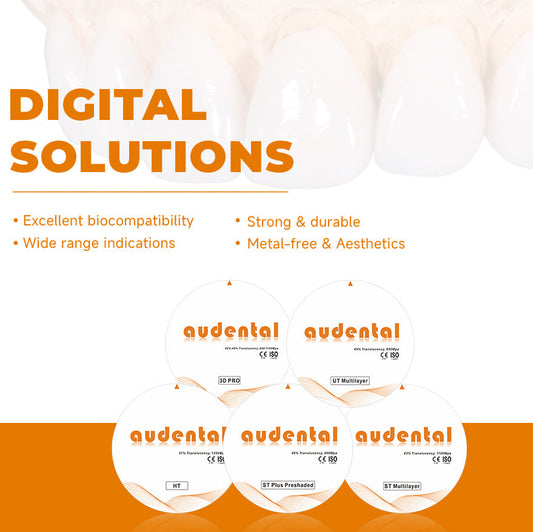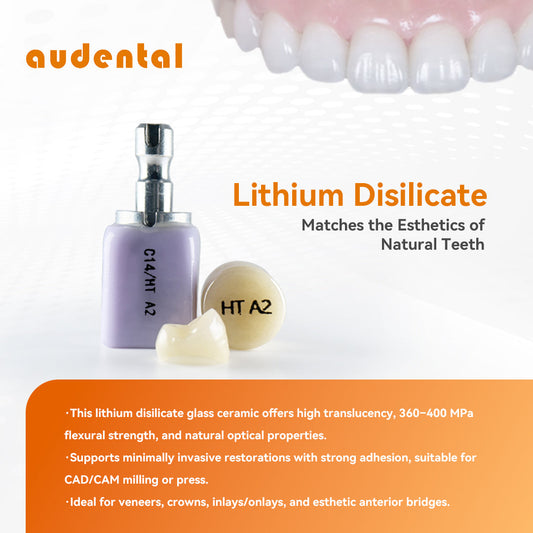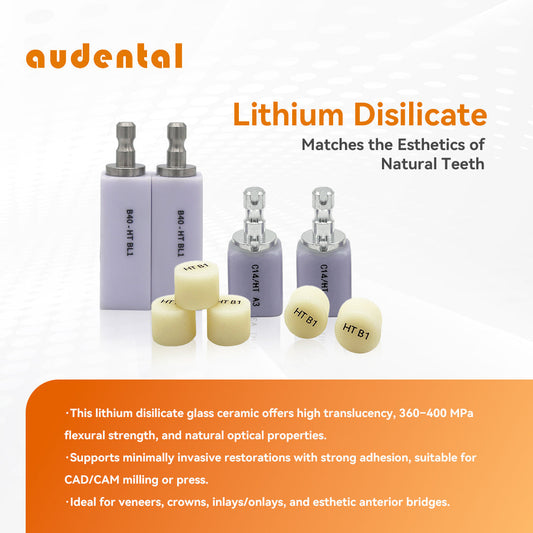Audental Zirconia: Innovation, Aesthetics, and Quality
Share
Introduction to Zirconia
(I) Basic Properties
Chemical Formula: ZrO₂
Molecular Weight: 123.22 g/mol
Appearance: White solid, typically in powder or crystalline form
Density: Approximately 5.68 g/cm³
Melting Point: Around 2715°C, classified as a high-melting-point material
Thermal Expansion Coefficient: Low, approximately 10×10⁻⁶/K, ensuring good thermal stability
Thermal Conductivity: Low, about 2-3 W/(m·K)
Hardness: High, with a Mohs hardness of approximately 8.5
(II) Crystal Phase Structures
Zirconia exists in three main crystalline phases:
1. Monoclinic Phase (Density: 5.68 g/cm³)
Predominantly present at room temperature and relatively unstable, prone to phase transformation.
When heated, monoclinic zirconia transforms into tetragonal or cubic phases.
Upon cooling, the high-temperature tetragonal or cubic phase reverts to the monoclinic phase, which involves volume expansion and may cause material fractures.
2. Tetragonal Phase (Density: 6.1 g/cm³)
Exists between 1170°C and 2370°C.
Stabilized at room temperature by adding yttria (Y₂O₃) and other stabilizers.
Exhibits excellent strength and toughness, making it widely used in dentistry and other high-strength applications.
3. Cubic Phase (Density: 6.27 g/cm³)
Forms at temperatures above 2370°C.
Offers high transparency but lower strength.
Can be stabilized at room temperature with yttria (Y₂O₃) additives, enhancing transparency.
(III) Yttria-Stabilized Zirconia (YSZ)
Common types of stabilized zirconia include:
3Y-TZP: Contains 3 mol% yttria, predominantly tetragonal phase, offering excellent mechanical properties and high strength.
4Y-TZP: Contains 4 mol% yttria, optimized for higher translucency in restorations.
5Y-TZP: Contains 5 mol% yttria, providing superior translucency, often used for anterior restorations but with slightly lower strength.
(IV) Advantages in Dental Restorations
1. Exceptional Mechanical Properties
High Strength:
Zirconia has a flexural strength of 900-1200 MPa, significantly higher than traditional ceramics (e.g., alumina ceramics: 400-600 MPa).Capable of withstanding high occlusal forces, making it suitable for posterior restorations and multi-unit bridges.
High Fracture Toughness:
Zirconia's fracture toughness helps resist crack propagation, reducing the risk of restoration failure.
Excellent Wear Resistance:
Zirconia's hardness is close to that of natural enamel, ensuring long-term durability and minimal wear.
2. Excellent Biocompatibility
Non-Toxic:
Zirconia is chemically inert and does not release harmful substances, ensuring no irritation or toxicity to human tissues.
Hypoallergenic:
Suitable for patients with metal allergies.
Antibacterial Properties:
Zirconia's smooth surface resists bacterial adhesion, promoting oral health.
3. Superior Aesthetic Outcomes
Natural Appearance:
Zirconia's translucency mimics natural enamel, achieving highly realistic esthetic results.
Color Adjustability:
Color can be customized via internal shading or external staining to match the patient's natural teeth.
Metal-Free:
Unlike traditional porcelain-fused-to-metal (PFM) crowns, zirconia restorations eliminate the risk of gingival dark lines.
4. Long-Term Stability
Chemical Stability:
Zirconia is resistant to corrosion and degradation in the oral environment, ensuring long-term performance stability.
Low Thermal Conductivity:
Minimizes temperature sensitivity, enhancing patient comfort.
Precise Marginal Fit:
CAD/CAM technology enables precise fabrication, ensuring an optimal fit with natural tooth structures, reducing microleakage and secondary caries.
Transformation Toughening:
A key toughening mechanism in zirconia, where phase transformation absorbs energy and suppresses crack propagation, significantly enhancing mechanical performance. This feature makes zirconia an ideal choice for high-strength, high-toughness dental restorations.
Audental Dental Zirconia Overview

(I) Research and Innovation
Audental has established a high-level R&D team led by Ph.D. experts and maintains close industry-academia collaborations with renowned universities worldwide. The company focuses on continuous product development and technological innovation, ensuring its leading position in core technologies and manufacturing processes.
(II) Manufacturing and Production
1. Raw Material Selection
3Y-TZP: 3 mol% yttria-stabilized tetragonal zirconia
90-100% tetragonal phase, 0-10% cubic phase
Translucency: 37-43%
Strength: 1100-1350 MPa
4Y-TZP: 4 mol% yttria-stabilized tetragonal zirconia
70-80% tetragonal phase, 20-30% cubic phase
Translucency: 43-46%
Strength: 900 MPa
5Y-TZP: 5 mol% yttria-stabilized tetragonal zirconia
50-60% tetragonal phase, 40-50% cubic phase
Translucency: 49-57%
Strength: 650 MPa
To meet esthetic restoration and processing requirements, we select high-quality 3Y, 4Y, and 5Y stabilized zirconia powders. These powders offer excellent mechanical properties and esthetic performance, ensuring optimal strength, durability, and natural tooth color matching. Different stabilized zirconia compositions (3Y, 4Y, 5Y) provide varying levels of translucency, strength, and crack resistance, catering to diverse clinical needs.
2. Production Process
Powder Blending
Dry Pressing
Cold Isostatic Pressing (CIP)
Pre-Sintering
Milling
3D Printing
Packaging




